Gossamer Gear The One tent is a one-person tent that hits all of my requirements in one small package. I’m picky about one-person tents, more so than with a two-person tent. Most two-person tents I’ve tested inherently feel bigger and have enough headroom, if only because they are obviously wider. One-person tents, however, can look coffin-like to me if they are very narrow and/or have a low ceiling. Like any piece of equipment, it’s a tricky balance between size, weight, features and price.
See my review of the Gossamer Gear Mariposa pack here.

Gossamer Gear The One one-person tent with door rolled back (Hood Mtn Regional Park).
Here’s my list of requirements: plenty of headroom, space inside to store my gear, a vestibule large enough to keep my pack and boots out of the elements, a view so I don’t feel claustrophobic. It has to be at or under three pounds, (preferably under two pounds). It doesn’t have to be free-standing but the set-up can’t be too fussy. It doesn’t have to have a separate fly and it doesn’t have to come with a footprint as I consider them to be optional. I jumped at the chance to test a Gossamer Gear The One tent as it appeared to meet my preferences. However, the proof is in field testing.
The One and The Two are Gossamer Gear’s one- and two-person tents, respectively. The names a very descriptive, aren’t they? The One is a non-freestanding tent that uses two trekking poles to provide structure and comes with 14 tent stakes (though it requires just six stakes at a minimum). The waterproof tent is made with silnylon fabric coated with polyurethane and has factory-sealed seams. It weighs 1 lb 13 7/8 ounces including stakes, lines and stuff sack but not the trekking poles. The tent has a bathtub design, meaning that the bottom is made of thicker silnylon and that piece rises up a few inches from the ground to prevent water from seeping into the tent (see specs and materials below). There are plenty of extra loops for additional guy lines to keep the tent secure in high winds. There is an internal mesh pocket and clothes line along the ceiling. The Two looks similar but is wide enough to accommodate two people and has two doors.
I set up the tent a couple of times in my backyard. The first time I set up a new tent, I try to do it without looking at the directions to see how intuitive it is. Then I do another round with the directions because I can almost always pick up some tips from the experts. In addition, my Gossamer Gear rep gave me a handy tip that I followed: once I got my Gossamer Gear LT trekking poles to the correct length (125 cm) for setting up the tent, I scored the metal so I could quickly twist them into place.
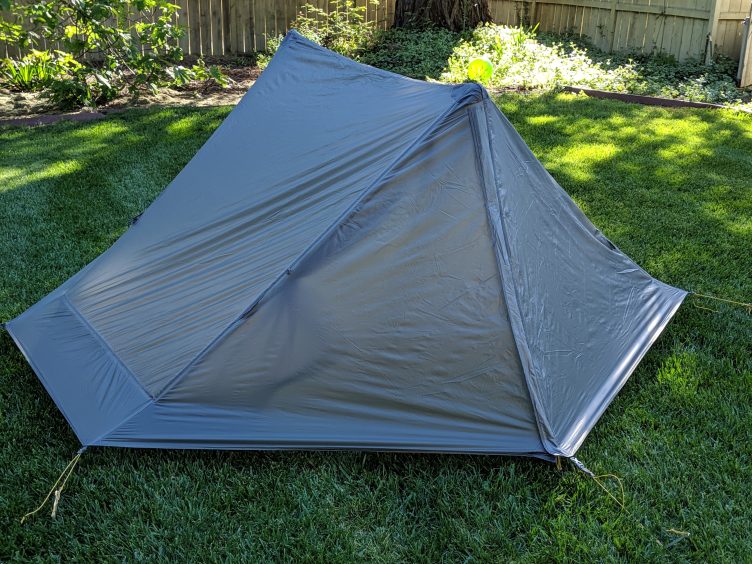
The One tent with door zipped up (backyard set up).
It was pretty easy to lay out the tent and figure out the general shape. I found a pocket on each side that accepted the top of the trekking pole and I set up the two poles first, inserting the tip into grommet tabs. There is a white circle of what looks like reinforcing material near where the grommet tie inserts into the tent which also makes it easy to visually identify the location. Then I started staking out the ties at the corners. The only tricky part was that there are two set of tie outs at each corner and I started with the inner/lower set. It’s more efficient to stake out the outer/upper set first as they provide the basic structure. The upper set flares out a bit forming a skinny skirt of sorts, which provides ventilation for a mesh layer. The body of the tent can left hanging free but if desired, the inner corners can be staked out as well. There are ties near the trekking poles that need to be staked as well. The minimum number stakes that can be used is six. The door is a side entry opening near one of the trekking poles. A mesh panel can be zipped to keep bugs out. A solid nylon panel zips to another panel to meet one of the tie outs to completely enclose the interior in case of rain but my assumption is that this would result in significant condensation. The only outside viewing opportunity is from the side where the entry is but the entire length of the tent can be opened up with a mesh wall. The solid panels in the front can both be rolled up and tied back. The other three sides are solid nylon panels. I will take care to position the tent (1) into the prevailing wind for stability, as suggested by the instructions and (2) for the view from the door.
In a rainstorm, it would be relatively fast to unfurl the tent, insert the trekking poles, stake out the four corners and then the front and back. The tent would be up quickly for all intents and purposes. The gear could be protected, you could jump in the tent and hopefully the storm would ease enough to fine tune it later.
On a backpacking trip that I was guiding, I had a group of ten, most of whom were novice backpackers. Speed was of the essence so I could get my tent set up, then assist everyone else with their gear, some of which was coming out of brand-new packaging. I was able to pop the poles in place, stake out the corners, do one more round to fine tune the stakes, blow up my pad and toss my gear inside.
Much later, when I finally got back to the tent to go to bed (exhausted), I was really impressed with the headroom of 46 inches at the peak. I tested a tent last year that grazed my head when I sat up so I was most pleased with this aspect. With my Therm-A-Rest Neo Air X-Lite sleeping pad, I found that I had an enormous amount of room on the side and end, almost enough for another skinny pad it seemed. For those looking for a one-person tent large enough to accommodate a dog (or even a small child), this tent could work.
The zippers worked flawlessly. One minor feature that I liked a lot was the pre-installed clothes line across the top with a small clip for hanging things. This is usually the first thing I set up in a new tent so I can hang socks, my sunglasses and other small items out of the way. I also appreciated a gear pocket for storing my phone and ditty bag. I know the little things have a weight cost but I love the convenience. Since it was a warm Northern California night, I left the vestibule doors open and did not experience any condensation. I positioned my tent away from the group so I had complete privacy, with a view into the woods. I didn’t get a chance to test it in wind or rain yet so I’ll have to report back after I can get the tent out on more trips.
When I got home, I added one small item. The mesh door could be rolled up and secured with a tie but there wasn’t one for the outer door. I added a short length of thin cord with a loop so I could secure both doors.
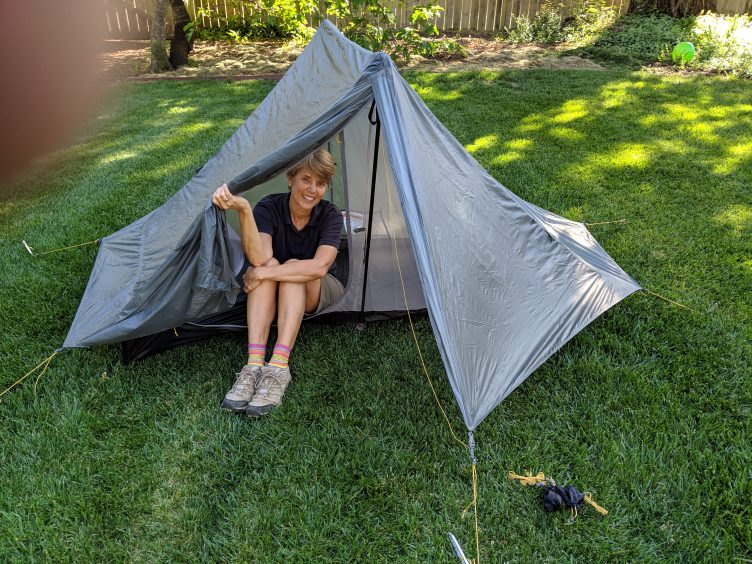
There is an abundance of headroom for this 5’8″ hiker (pardon the extra finger).
The One tent from Gossamer Gear met all of my expectations for a solo tent. I found it to be easy to set up, comfortable to be in and light weight. It has all the headroom and storage space I need, and I liked the open views and ventilation from the front.
So far, I can’t identify any downsides in terms of my requirements. However, to mention a few considerations that factor in for a tent of this type, I can say that the ultralight crowd will note that there are slightly lighter, though generally more expensive, tents out there (e.g. sub-one pound), there are free-standing, though generally heavier tents and in any single wall tent, condensation can be an issue if the doors are fully closed and it’s a moist environment. It requires trekking poles or optional poles that can be purchased from Gossamer Gear.
The One tent is available from Gossamer Gear for $299.
Pole sets may be purchased from Gossamer Gear for $38.
Weight per author’s digital kitchen scale: 1 lb, 13 7/8 oz (includes shelter, lines, stuff sack, tie outs, 14 stakes).
Specs per Gossamer Gear
Average Weight:
Dimensions:
Materials:
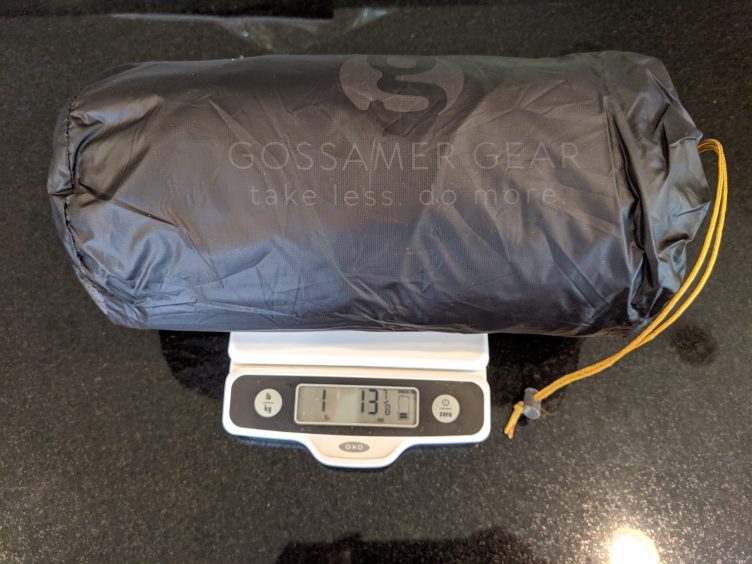
Weight per my kitchen scale.
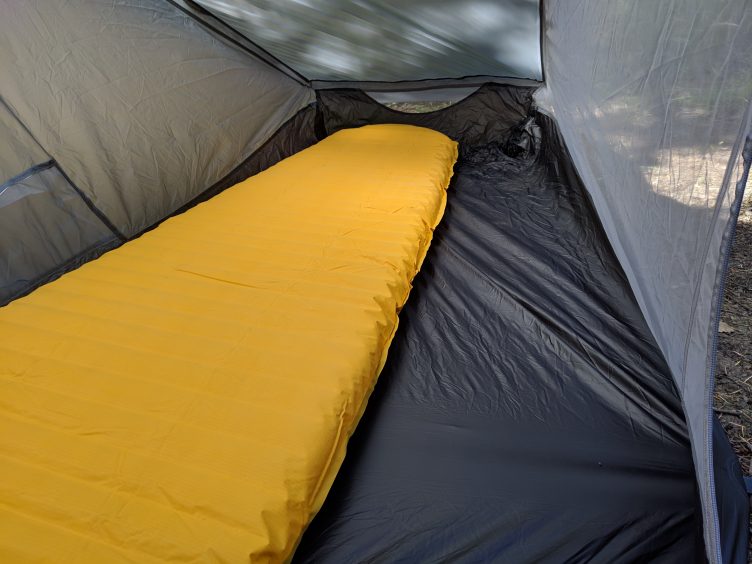
Even with my Thermarest NeoAir Xlite inflatable pad, there is still a large amount of storage space along the side.
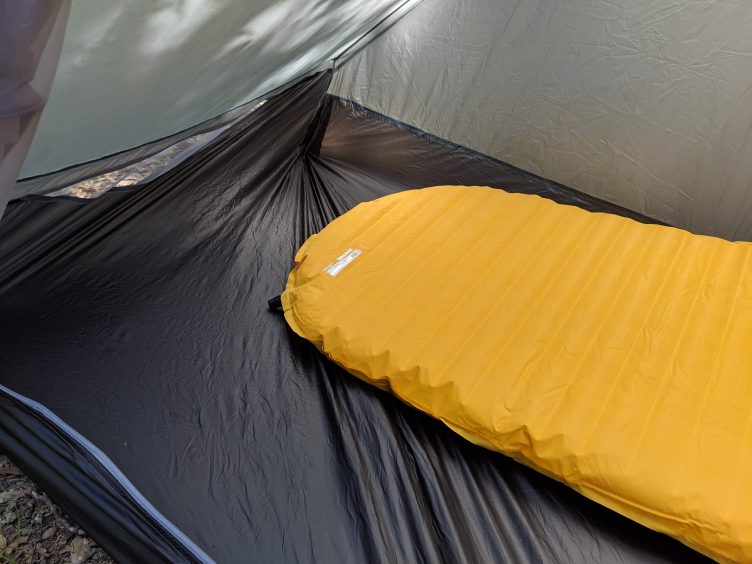
There is also room at the end to store belongings.
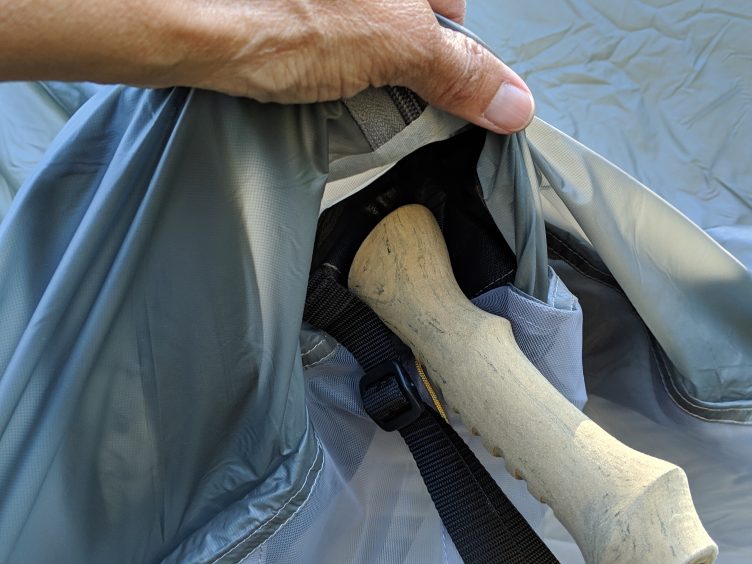
The end of the Gossamer Gear L4 trekking pole fits into a small pocket.
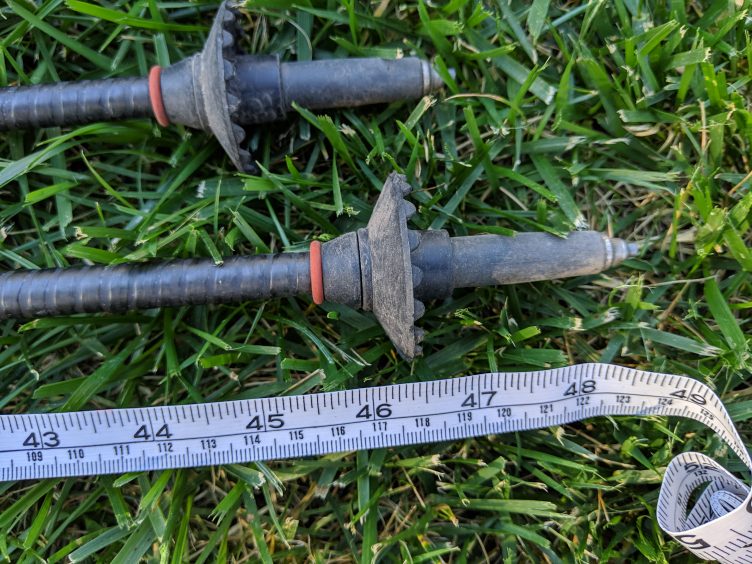
Measure 125 cm length for the trekking poles.
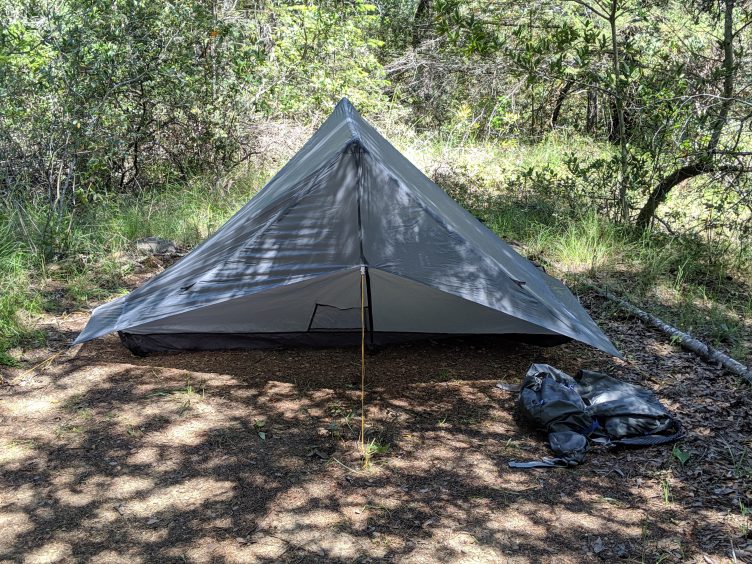
Back of The One. You can see the outline of the wall pocket.
All photos by Inga Aksamit, unless otherwise credited.
Disclosure of material connection: I received a sample for testing purposes, but the opinions expressed ar
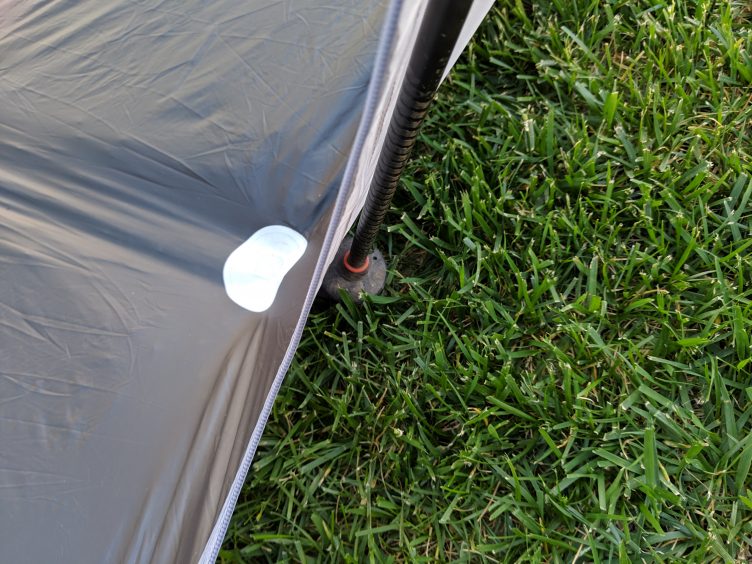
When laying out the tent, look for the white circles to quickly identify the grommets for the end of the trekking pole.
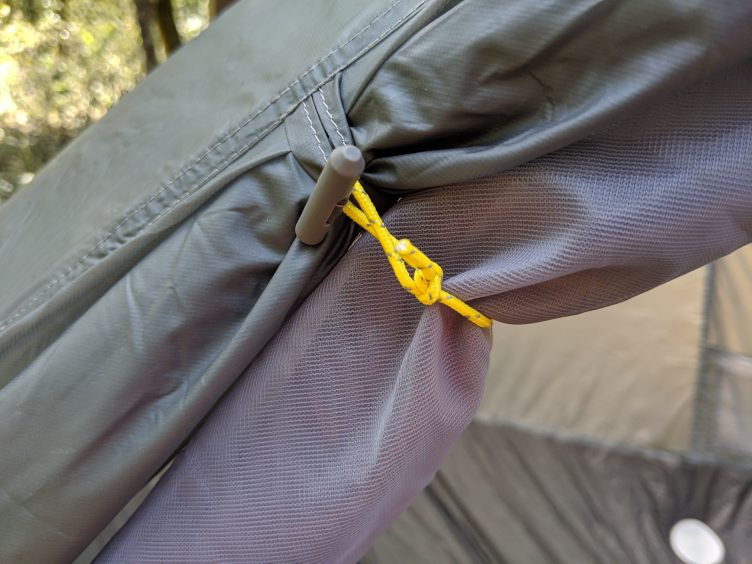
I added a short length of yellow cord so I can roll up the mesh door and external panel at the same time.

Pre-installed clothesline and loop–very handy.
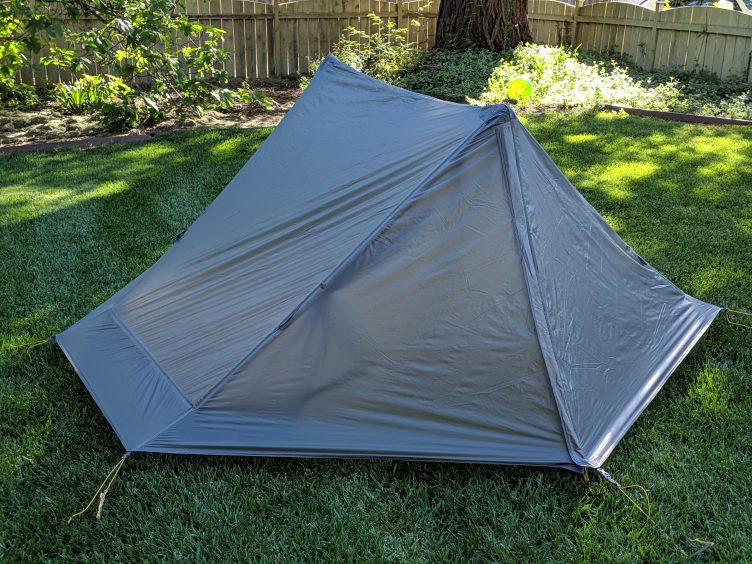
Gossamer Gear The One Tent has all the features on my checklist: light, compact, lots of headroom and storage, opens up to provide views.
e solely my own.
 Previous Post
Previous Post

Lori Rogers says:
Thanks for the thorough review! Have you had a chance to use it in wind and rain? If so, did you find anything that changes your review significantly ?
Inga says:
Hi Lori, Rain is fine–just zip up. Wind is manageable by taking some care with staking. There are plenty of extra places to stake so if big winds are expected, bring extra stakes and make sure everything is taut.
Michael says:
How does it handle condensation?
Inga says:
Like any single wall tent, condensation can be an issue in certain environments. It’s best to take some care with site selection and don’t camp in a low hollow or near a meadow or water. If you get up where you can catch a breeze, it helps a lot. I have a small camp towel handy for mornings when there might be a little dampness.
Inga